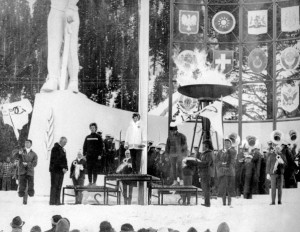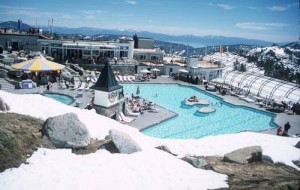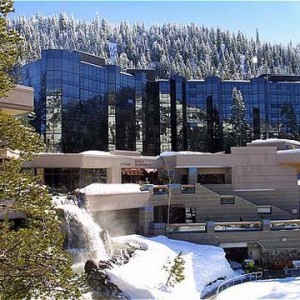John Henwood, March 2011
At the approach to Squaw Valley the Olympic rings are proudly displayed alongside a plinth on which the eternal flame that epitomises sporting achievement permanently flickers. At first one could be forgiven for thinking that the Winter Olympics were a recent event here, but no fewer than thirteen Olympiads have come and gone since that flame was ignited for the 1960 games.
There is a sense that Squaw Valley is living and trading on former glory, a feeling that is perpetuated with photographic displays of those games and the remnants of last year’s celebration of the 50th anniversary of the event. It is a rather odd phenomenon because Squaw Valley has plenty to recommend it today and there is surely no need to continue promoting the past when there is so much to enjoy in the present.
Let’s start with access. Squaw Valley is one of a ring of ski resorts that surround Lake Tahoe, which lays half in Nevada, half in California; it is about six miles west of Tahoe City. An easy 45 minute journey from Reno airport in all but the most difficult of conditions (when it can take up to half an hour longer) the roads are good, well signed and kept open through the severest of winters. Of course that’s the last lap of a long journey from the UK, which for us involved a ten-hour flight to San Francisco, some marking time and then an hour flight on to Reno.
Lake Tahoe is interesting; it’s about 72 square miles of deep water and however cold the weather it never freezes. It’s fed by several small rivers and is in the main filled annually by snowmelt; outflow is controlled via Tahoe City. Now let’s be clear, this is not a city in the generally accepted European sense; it takes less than ten minutes to walk from one end to the other, but it’s a rewarding stroll if you take the shore path with it’s beautiful views of the Lake surrounded by snow-capped mountains. We were told – and it’s easy to believe – that its summer attractions are even greater than those of winter. Our walk took in Rosie’s Bar in the centre of Tahoe City where a quick drink turned into a leisurely dinner. The place has a great history and an atmosphere generated by vintage bicycles and other period ephemera that adorn the walls as well as the good ol’ boys that inhabit the bar. Rosie’s is a must do. We had bumped into town on the Tahoe Area Recreational Transport – TART for short, which as its name might be taken to imply does not have a great reputation. However, the buses turn up, eventually, and go where they say they’re going until early evening when the Night Rider, a free bus connecting Lake and resorts, replaces the service. But enough of peripherals, you want to know about the skiing. Well it’s pretty good. Being a diligent reporter I took a look at the beginners’ areas, the principal one being accessed by the cable car, which deposits its cargo at High Camp (why does that bring to mind Frankie Howerd? “Oooh noo, please, it’s wicked to mock the afflicted!”) where broad gentle slopes are served by a number of slow 2 and 3 person chair lifts. High Camp, built for the Olympics and renovated in the 1990s, boasts an outdoors swimming pool and a skating rink as well as catering facilities and from the sun decks amazing views of Lake Tahoe. The other beginners’ area is in the village where the youngest and smallest are gently introduced to the pleasures of falling over.
The rest of the area, comprising five peaks, is given over to intermediate, advanced and expert practitioners and there’s plenty of each. I was not sure what the local difference between advanced and expert might be and, having experienced both, I’m still not entirely sure. I did discover that some advanced slopes are groomed though usually vertiginously steep whereas the expert areas tended to be largely untouched by the groomers. The more challenging areas are for the most part well served by modern 4 and 6 person chair lifts, but there are too many of the old, slow 2 and 3 person chairs in use, some appearing to date back to the former Olympic glory days and overdue for upgrading. The main route to the west, and main side of the action is the Funitel gondola, which opens up the Shirley Lake and Solitude areas – medium-long tree lined bowls with plenty of variety, not unduly daunting for the intermediate level skier. It is also the route to the Gold Coast lifts all accessing a vast bowl with an immense variety of ways down. At first I looked for route markers, but they do not appear either on maps or mountain: the view is that Squaw Valley offers big bowl skiing and the operators don’t want to be prescriptive about how one should get from top to bottom. After a while the absence of markers is quite liberating. Headwall Express invites some of the more challenging options to the east of the Gold Coast bowl, while further east still KT-22 (so called because the first to attempt a descent needed 22 kick turns to achieve it) also gets the pulse rate up. We stayed at the Resort at Squaw Creek, away from Squaw Valley village, but with it’s own lift to the top of Snow King at 7,500 feet from where the village and access to all points is possible. It’s a ski in/ski out resort, but be aware the return journey necessitates a ride on Red Dog, an interminably slow old three-person chair. The alternative is to ski into the village and pick up the free Resort shuttle that runs every half hour.
Everyone told us California skiing is warmer than the Colorado, Wyoming or Montana options and so it is. We skied our first week in brilliant sunshine and above freezing temperatures. And because they are so good at looking after their slopes the under-ski conditions were remarkably good despite the fact that they had had no appreciable new snow for several weeks. Then we experienced the other side of the coin; it started snowing and in four days we had four feet of fresh stuff to work with. The problem was with the snow came the wind and visibility was very poor. Also, half the lifts were closed so more than half the area was unavailable. Regulars were familiar with this. We learned that the vast majority of Squaw Valley’s business comes from Sacramento, just a two-hour drive away, and the San Francisco bay area, about three and a half hours by car. So, most of the money is made at weekends and the operators have a habit of closing areas for grooming in order to open them in pristine condition at weekends. Fine if you’re a weekender, frustrating if you’re not. Squaw Valley is in relatively new ownership, it’s now part of KSL, a huge luxury property management business and they seem to be more enterprising than the prior owners. For example, they are beginning to reduce the cost of lift passes reasoning the more people they attract the greater will be their secondary income from ski rentals, bars, catering and other incidentals. No doubt the competition with other Lake Tahoe ski areas is fierce. It has to be said après ski is not the greatest. We enjoyed the Auld Dubliner Irish Pub – yes it’s a cliché, but they do it well, with a pint of local brew and a whisky chaser for $7. The Fireside Pizza Company does great spaghetti and meatballs and if you want to watch sport – on a dozen or more screens – the Blue Coyote is good fun. Fine dining as we know it in Europe doesn’t really exist, but Graham’s probably come closest (it’s hard to be pretentious when your clients are still in anoraks, but they try) and Sandy’s Pub in the Squaw Creek Resort is excellent. Let me be clear, because of the distance from the UK Squaw Valley is not a cheap option and if you choose the Squaw Creek Resort you’ll find yourself at the higher reaches of the market. That said, it does offer reasonably good value for money. Where does Squaw Valley rank alongside other North American ski resorts? That’s a tough one because they all offer something different. I’d say it’s somewhere between Whistler/Blackcomb, which has more of everything, and a boutique resort like Beaver Creek, which has less, but does it a bit better. But it would be wrong to damn Squaw Valley with faint praise; it has Lake Tahoe just down the road and, if you tire of what it to has to offer, well drive round the Lake to Alpine Meadows or Heavenly or Northstar or (I could go on) and few other ski areas can match that.
John Henwood travelled with Ski Independence in February 2011



